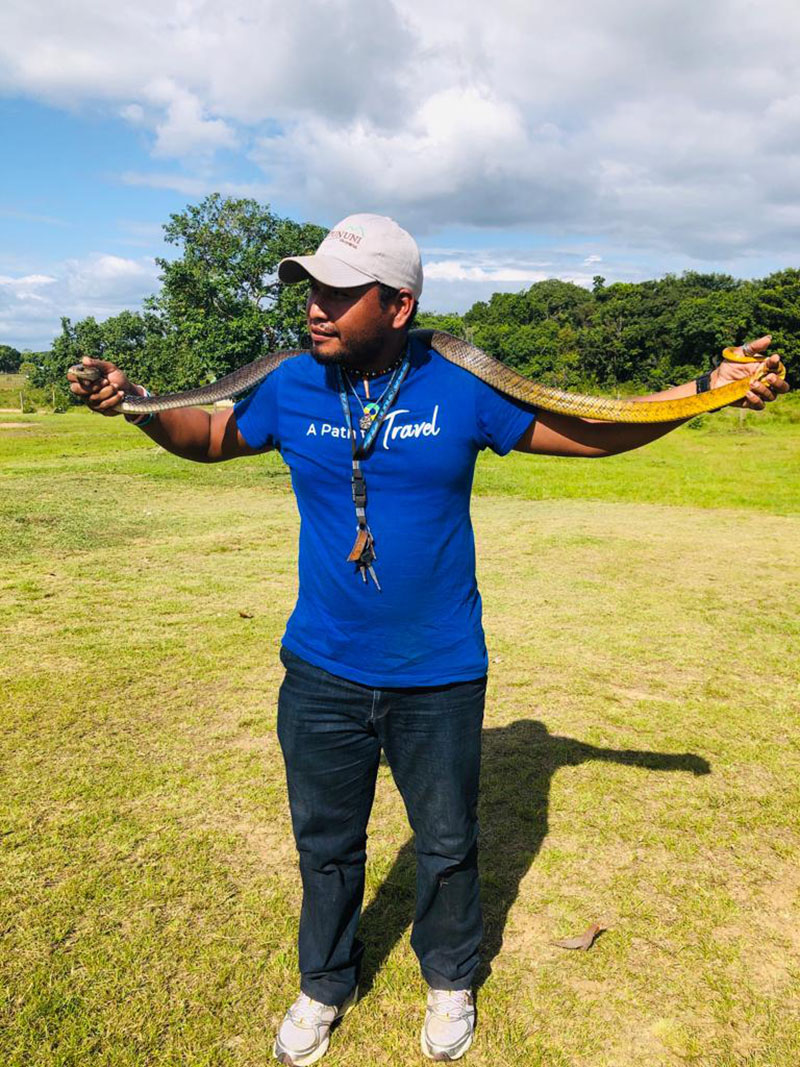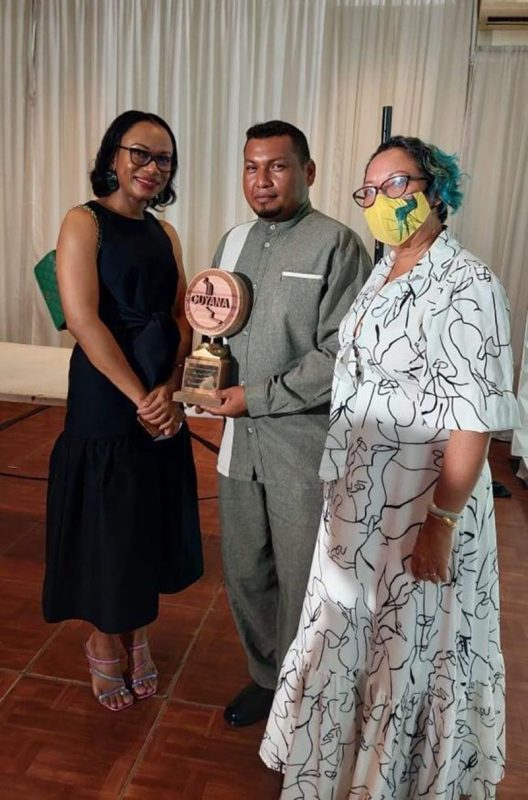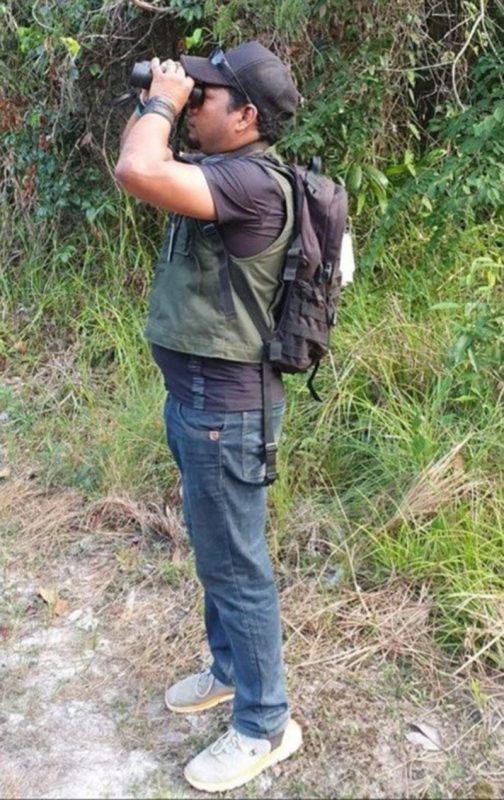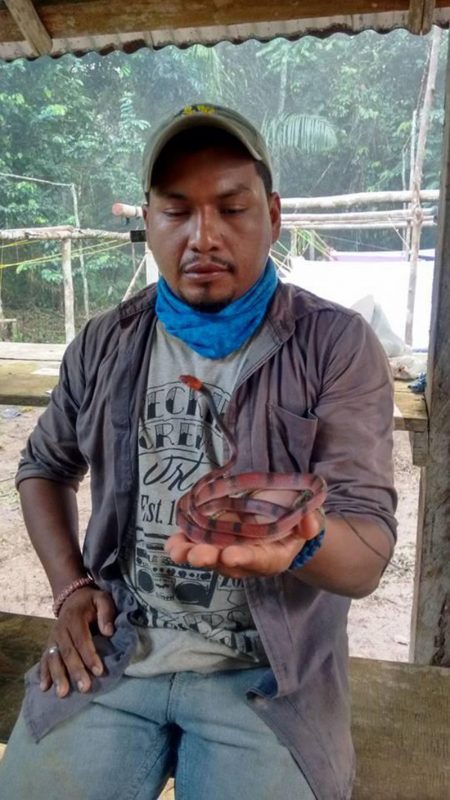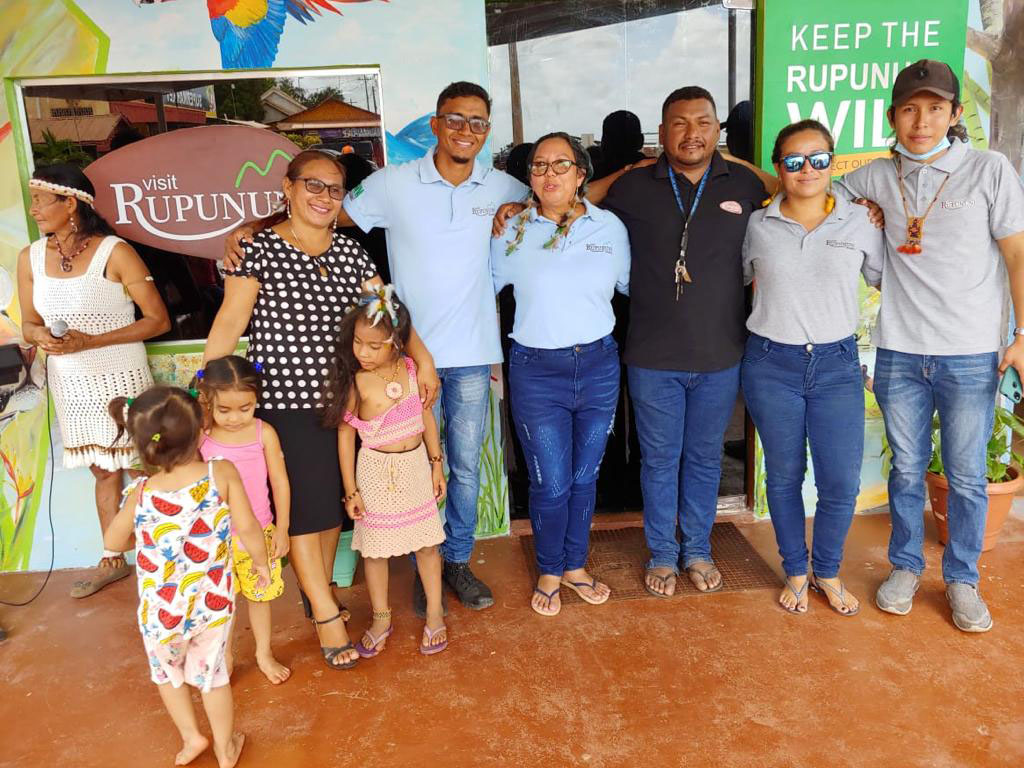Education and awareness of the importance of Guyana’s biodiversity and the Indigenous Peoples’ culture are among the objectives of tour packages offered by the company of award-winning specialist tour guide, master trainer and herpetologist Kenneth Butler Jnr.
“My major goals include using educational tourism to make people aware about the importance of nature, conservation and the Indigenous Peoples’ way of life. My packages that involve students include student exchanges with Indigenous communities,” Butler told Stabroek Weekend in an interview.
From Surama, Region Nine (Upper Essequibo/Upper Takutu), Butler, 35, grew up with his paternal grandparents from the age of four and returned to Surama to join his parents after completing tertiary education. After writing “common entrance” he was placed at Carmel Community High School and transferred to Charlestown Secondary when his performance improved. He then pursued electrical engineering at the Government Technical Institute and completed his studies in that field with a bachelor’s degree in electrical engineering at the University of Guyana (UG).
While at UG, he worked at the Catholic Standard newspaper and on completion of his studies in 2009, he moved back to Surama where he could not use his skills in electrical work.
“For me my life’s work had to be with nature and science. One of the reasons I returned to Surama was that I did not grow up with my mother who lives there,” he said. “I decided to reconnect with my family and get to know my culture and better understand my identity. My father is from the Arawak nation… and my mother is Makushi and Arawak but she practises the Makushi culture and speaks the language which I did not know.”
With no job opening in the electrical engineering field in Surama, Butler found employment in logistics with Mekdeci Machinery and Construction Inc (MMC) where he worked for 18 months. He then decided to get into tourism at Surama and applied to become a tour guide.
“Growing up, my love for nature began during school holidays while visiting Surama. I always wanted to know more about the forests and the animals that were in it,” he said. “When I got the opportunity to get into tourism, I applied for the job as logistics manager with Surama Eco Lodge. I spent two years at Surama working in logistics and training to be a tour guide.”
Given the opportunity to do a two-year online course in biology and ecology with the University of Missouri-St Louis, USA, from 2012 to 2014, he resigned as logistics manager. However, he continued working part time as a tour guide with the eco-lodge and other tour operators in the region. “Because I was already working in the field, I just had to do the theoretical aspects,” he said of his online studies. After obtaining diplomas in biology and ecology, he once again worked full time with the eco lodge for a year, but as assistant logistics manager.
Green Diamond Nature Tours
In 2016, he started his company Green Diamond Nature Tours (GDNT) which offers adventure, culture, nature and wildlife, photo and educational tourism.
“We developed a six-week exchange programme called art and science with Rhode Island School of Designs, a private art and design college in the USA. Mainly second-year students, they come every other year to experience what it is to be a researcher and incorporate art in conservation and nature. With data they gather in the field, they then transpose it to an art piece to explain their work,” he said.
When the students arrive in Guyana, they spend four days in Georgetown viewing landmarks and being exposed to the culture of the city after which they travel to Iwokrama River Lodge for three nights where they learn how to monitor the forest as a conservation area. They then move to Surama Village for two weeks where they team up with an Indigenous person from the community to do their projects.
“They would share their knowledge in art with that Indigenous person and the Indigenous person would teach them the cultural side of the village. It is done in a way in which they learn from each other. That would factor into the data the students collect. The students would also explain how they see things from their points of view as artists and show the Indigenous people how they can create visual art,” he explained. After the two weeks they visit Caiman House, another eco-lodge and resource centre in Yupukari Village where they are exposed to traditional cotton spinning, weaving and art and craft before returning to the city.
Most of the students on the exchanges are mainly from the USA and Asian countries; their study disciplines include architecture and a mixture of art and design.
Generally, GDNT offers three tourism packages, nature, adventure and a cultural exchange. The nature trip which takes between 14 to 16 days starts in Georgetown followed by trips to Kaieteur Iwokrama, Surama, Yupukari, Witchibai and Lethem.
The adventure aspect includes a river trip, a visit to Iwokrama, two to three nights camping in the rainforest or in a riverain area to coexist with nature, learning to gather wild fruits to survive and identifying herbal plants.
The cultural experience is stretched across Surama and Yupukari Village. Visitors experience a traditional lifestyle: processing the cassava root to a grain for making farine or cassava bread, fishing, eating traditional meals, farming, basketry, weaving and spinning cotton, lighting a fire the traditional way, cooking on a fireside and learning how to prepare a traditional meal.
“I also have a build-yourself product where you take experiences from the three and make your own package,” Butler said. “A lot of the clients return and bring friends and family.”
Most of the time he works alone, but if the group is large he employs other guides and drivers. Since the onset of Covid-19, Butler said, like the rest of the country his work was badly affected. He was at home for a year without a job. In the second year of the pandemic, Butler took part in a scholarship programme which focused on art and conservation in communities. His study was on the impacts of tourism on community trails in Surama. Two young artists who joined forces with him did visual observations of the trails in Surama on bird life, mammals, reptiles, amphibians and insects for two weeks of every month for the year.
They did monthly reports, took photos as part of data collection and the two artists described in their artwork the things they learned. They were paid a stipend from which Butler did a publication on butterflies in Surama village.
“I did this in collaboration with Priya Manjar of UG. It was basically sponsored by the Field Guides Field Museum in the US. It is a small collection of selected butterflies,” he stated.
Butler also worked with a number of organisations that partnered with the Iwokrama Eco Lodge over a period of two years on different projects. These included wildlife monitoring, bird tagging with different biological companies including Operation Wallacea, and as a herpetologist for five years on their summer courses. Operation Wallacea is an international biodiversity conservation and climate research programme which brings researchers together who work with university students across the world.
Herpetologist
Working as a herpetologist and specialist tour guide to Steve Blackshall, the British naturalist and presenter with BBC TV on the show Deadly 60, in which Blackshall tracked the 60 deadliest animals in the world, Butler said, was a learning experience.
“One of the Deadly 60 we encountered in Surama was the Wandering Spider, which is among the world’s deadliest spiders. It is known for attacking people and for the amount of bites it inflicts on its victim,” he expounded.
Blackshall’s crew also spotted the bumblebee poison dart frog. “Traditionally Indigenous People rubbed their arrow points on the back of this deadly little frog to make the arrow potent enough to kill game while hunting or fishing. The poison wouldn’t affect the food because of the traditional way of preparing the meat by a method the Makushi call ‘kambo’. [They place the meat over fire to extract liquids from the meat.]
“We did not get to see the anaconda which Blackshall so badly wanted to see, but he saw the yellow tail cribo or indigo snake which is non venomous but feeds off the venomous snakes like labaria, bushmaster, rattle snakes and other smaller ones. It is a beautiful snake that grows to about eight to nine feet,” Butler said. They also saw the harpy eagle, black caiman, giant anteater and giant otters.
Butler completed a stint with “A Perfect Planet” television series and in 2019 he worked on contract with Tokyo TV, a Japanese TV programme that looked at some of the giant species of animals found in Guyana. They were also interested in the golden frog and bromeliads found at Kaieteur Falls, the jabiru stork, which is among the largest in the world, and some owls.
Among the giants that are not easily seen, Butler said, is the endangered arapaima, the world’s largest freshwater fish. “It comes up to take breaths every 15 to 20 minutes. You only see when it rolls over in the water. Other than that you have to do sport fishing which is catch and release,” he said.
Tour guide training manual
Over the last five years, Butler completed a number of training programmes with the Guyana Tourism Authority (GTA) and with some international organisations to help raise the standard of his company and the tourism product in Region Nine.
As a master guide, he facilitates training of other guides. “I am one of 19 guides licensed by the GTA. I have been in the business for 13 years now and I want to be seen as a role model for more guides coming into the profession,” he said.
At present, Butler is assisting the GTA to facilitate training of tour guides and product development for new tour operators entering the industry. He has pioneered the local training of tour guides.
In 2018 after completing a master training course, he helped in training younger guides in Moraikobai, Region Five (Mahaica/Berbice).
“GTA asked me to develop a tour guide manual to use with my charges,” he said. “I created the Tour Guide Manual for Guyana. From then to now I have been working with GTA on a rotational basis. I have upgraded the manual, a naturalist guide. I’m on volume three currently. I consulted with my past trainers to develop the manual and I used some of their materials they shared. They have been giving me feedback. So far the manual is still a work in progress and as things change and the world of tourism develops, the manual will have to be updated.”
Butler is the representative of the North Rupununi on the board of directors of Visit Rupununi, Guyana’s first regional destination management organisation. It was created to help new communities stepping into tourism to develop their product.
“Over the last five years, Visit Rupununi has grown from when it was founded. We’ve launched our office next to Lethem Airstrip. More established in the region, we are collaborating with GTA to train operators in other communities to upgrade their standards,” he said. Many emerging destinations in Region Nine include Waikin Lodge, a ranch and eco lodge area in Central Rupununi, Toko Village, Quarry Village, St Ignatius, Witchibai, Dadanawa, Aishalton, Saddle Mountain, Central Lethem, Moco Moco, Kumu and Sky Valley.
The sun parakeet, a protected species, can be found in Karasabai and Butler said, “Karasabai is working with an international birding organisation to create nesting boxes to increase the population of the birds in the region.”
The red siskin, another endangered and protected species, is found in Sand Creek and Witchiba. It is being monitored by the South Rupununi Conservation Society. Rangers who are trained in the netting of birds do population counts every season.
“Bird watching is actually one of the biggest products for tourism in Guyana,” Butler noted.
